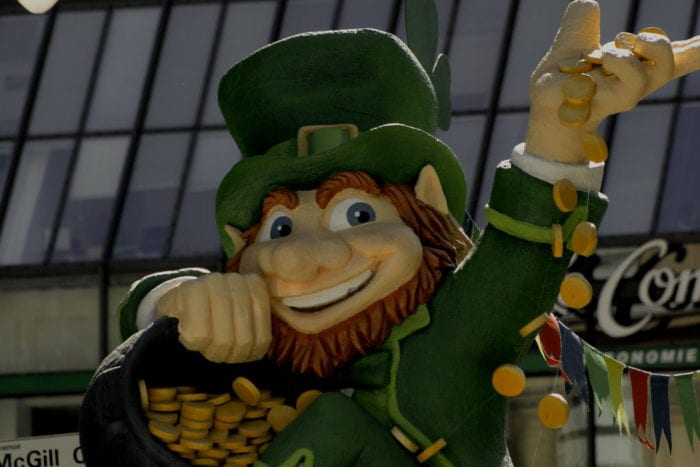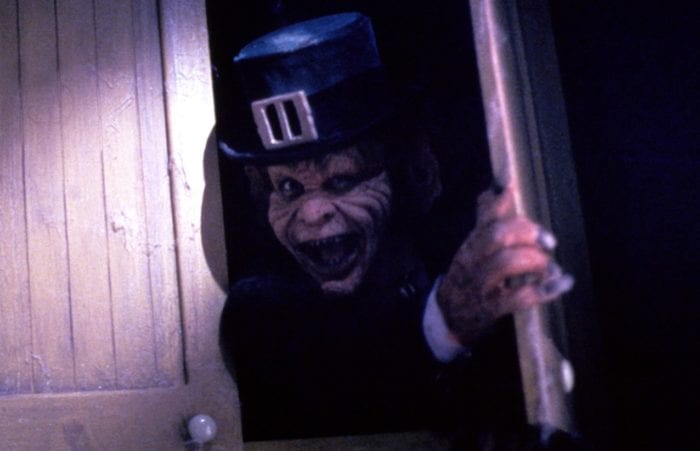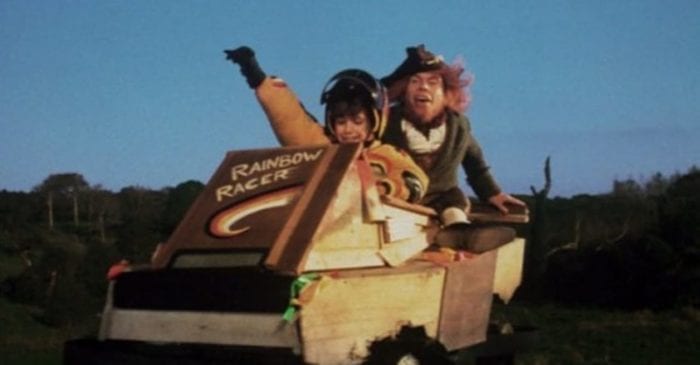Growing up in the U.S., images of leprechauns were everywhere during this time of year as a symbol associated with St. Patrick’s Day. Besides that, there was the commercial for Lucky Charms cereal with the upbeat, charming leprechaun mascot, Lucky, aka Sir Charms. Leprechauns eventually made their way into the horror genre, with the 1993 film Leprechaun, starring Warwick Davis as a not-so-happy-go-lucky leprechaun, Lubdan, who will kill for his pot of gold. The film spawned a series with eight films, the last being Leprechaun Returns (2018).
What are the origins of the leprechaun, and why are they specifically associated with St. Patrick’s Day? St. Patrick’s Day commemorates the death of its namesake, a fourth-century missionary who became the patron saint of Ireland. St. Patrick’s Day was first observed during the ninth or tenth century as a religious holiday that was originally a day for prayer and reflection. It has evolved into a celebration of Irish heritage and culture, a day to party with parades, and in the U.S., a traditional dinner of corned beef and cabbage. Leprechauns have become the mascot for St. Patrick’s Day.
As with any mythological being, there are many theories as to the exact origin of leprechauns. I’d like to start with the origin of the word leprechaun. Some sources say that leprechaun stems from the Irish leath bhrogan (which is translated as ‘shoemaker’) or the word luchorpan (meaning ‘small body’). Another possibility is that it is from the word lucharma’n (meaning ‘pygmy’). Leprechaun was originally used only in the north Leinster area. In other parts of Ireland, leprechauns were known as lurican, lurachmain, and lurgadhan. The origins of the leprechaun are pre-Christian. In his book The Truth About Leprechauns (2000), Robert Curran wrote: “He may have started as a vague and ill-defined folk memory of some diminutive race that once coexisted with the early Celts.” Curran wrote that leprechaun lore is complicated, even saying that the leprechaun may not have originated specifically in Ireland, but may even have originated from parts of Scotland or Brittany, France.

Other sources say that leprechauns are descendants of the Tuatha Dé Dannan (folk of the goddess Danu), a group of supernatural beings, who were part of the pantheon of gods in pre-Christian Irish culture. According to Irish mythology, these beings invaded Ireland during ancient times. While they lived in their dimension, they interacted with the human world. Like other cultures where there was widespread conversion to Christianity—the old beliefs were interwoven with the new beliefs. The recent American adoption of the Austrian/German Krampus is one example. In Norse mythology, Krampus is the son of Hel, God of the underworld. Krampus chased away winter ghosts during the winter solstice. After the winter solstice evolved into Christmas, and Santa Claus became part of Western Christmas tradition, Austria and parts of Germany retained Krampus. He became Santa’s foul-tempered helper who punishes ill-behaved children with beatings and by dragging them to the underworld to be eaten. The rabbit’s association with Easter is also similar. Some authors on mythology and folklore have stated that the hare was a companion of Ostara/Eostre, the Saxon goddess of Spring. Keeping pre-Christian imagery was perhaps a compromise. Many happy current holidays were festival days during the pre-Christian era which were a celebration of the changing of the seasons. Incorporating pre-Christian imagery maybe was thought of as making the conversion to Christianity easier and more appealing. Perhaps, the expression that old habits die hard applies. The beliefs were so ingrained in the people’s minds that they had to keep them there in some form.
Leprechauns are a type of fairy. Normally when we think of fairies, we think of small, feminine beings with sparkly attire and wings, but fairy lore is very diverse, including beings such as leprechauns, Norse elves, and English brownies. Leprechauns are masculine beings, a few inches tall, dressed in green (red originally), with buckled shoes and a pointed hat (now usually a top hat), sometimes a leather apron, and usually smokes a pipe. Samuel Lover describes the original appearance of the leprechaun in Legends and Stories of Ireland (1831): “He wears a red square-cut coat, richly laced with gold, and the inexpressible of the same, cocked hat, shoes, and buckles.”
Described as loners by nature, leprechauns had a reputation for being surly, and prone to mischief and trickery. They are also described as foul-tempered, lustful, and moody—delightful one minute, but dangerous if displeased. Leprechauns always have a pot of gold that they keep hidden. Why a pot of gold? Leprechauns have a specific purpose in the fairy realm. They work as cobblers. According to fairy lore, all fairies love to dance, so they wear out their shoes quite often. The leprechaun, as a cobbler, is an important person in the fairy community. A tapping noise of a small hammer driving nails into tiny shoes is said to announce a leprechaun’s presence.

The leprechaun’s very lucrative trade as a fairy cobbler is what provides their treasured pot of gold. The leprechaun’s pot of gold is the fruit of his hard work, hidden at the end of a rainbow. Another explanation for the leprechaun’s pot of gold is that leprechauns are the bankers of the fairy world. Therefore, the gold doesn’t belong to the leprechaun but belongs to other fairies, who gave it to the leprechaun to keep safe. According to this version of the lore, a leprechaun isn’t being miserly by protecting his pot of gold but fulfilling a duty to keep the treasure of the fairy realm safe.
Anyone who captures a leprechaun has a chance at winning his legendary treasure. When captured, leprechauns are said, like genies, to grant three wishes. However, the leprechaun has a reputation for being a trickster, and those who cross paths with them are warned not to trust them. Folklorist Carol Rose tells the following tale about a leprechaun typical of leprechaun lore in her encyclopedia Spirits, Fairies, Leprechauns, and Goblins, “…concerning a man who managed to get a leprechaun to show him the bush in the field where his treasure was located. Having no spade [shovel], the man marked the tree with one of his red garters, then kindly released the sprite and went for a spade. Returning almost instantly he found that every one of the numerous trees in the field sported a red garter!” Leprechauns are exclusively male. An explanation for this is that leprechauns are the unwanted offspring of fairies who were abandoned due to a physical abnormality. This could also serve as an explanation for the leprechaun’s surly nature and their solitary tendencies.

So, how did the leprechaun start dressing in green and what does the leprechaun have to do with St. Patrick’s Day? Green was adopted as the color for St. Patrick’s Day because of its association with Ireland. The green stripe in the Irish flag symbolizes Roman Catholics, (orange symbolizes Protestants and white symbolizes the truce between the two), as well as Ireland, is known as The Emerald Isle. The other symbol of St. Patrick’s Day, the shamrock, is associated with St. Patrick. He’s said to have used the three green leaves to teach people about the Christian Holy Trinity (God the Father, God the Son, and God, the Holy Spirit). This also could have additionally cemented green as the color for St. Patrick’s Day (the original color was blue, the official color of the Order of St. Patrick). While shamrocks have a direct association, leprechauns don’t. As St. Patrick’s Day has become an overall celebration of Irish heritage, the leprechaun has become associated with St. Patrick’s Day as part of traditional Irish folklore. Having a love for dancing as well as a good drink, the fairy cobbler fits on with the current celebratory spirit of the day.
Leprechauns evolved as many other mythological beings have evolved throughout the ages. Currently, they are depicted as both benign and malevolent. Smiling leprechauns, dressed in their green suits, with rainbows and pots of gold are used in St. Patrick’s Day decorations. On the other hand, there’s the leprechaun Lubdan of the Leprechaun horror film series, who will go to homicidal lengths to retrieve his pot of gold. In the traditional lore, the leprechaun is both. So, beware this St. Patrick’s Day if you hear the tapping of a tiny hammer. The leprechaun could be your ticket to your pot of gold at the end of the rainbow if you’re lucky, but beware if he’s not in a good mood—and remember to never take your eye off this mischievous sprite.



